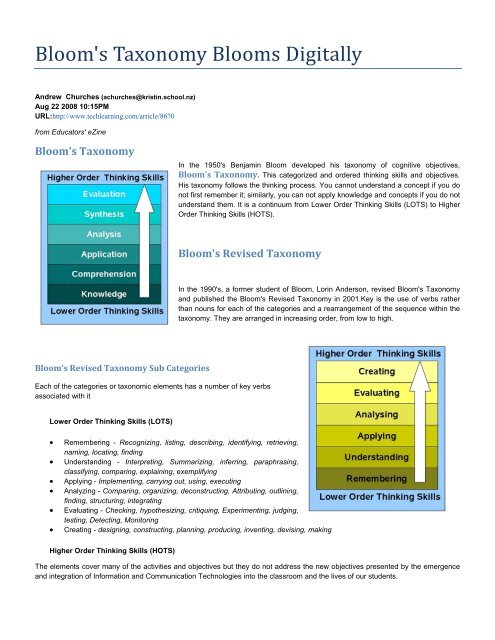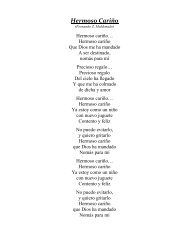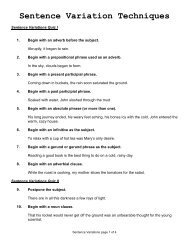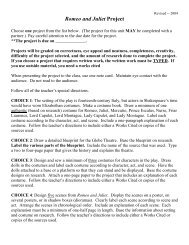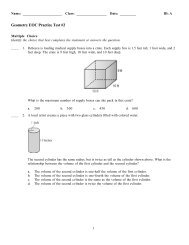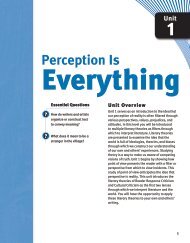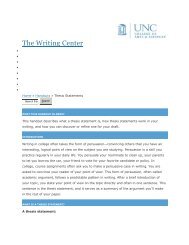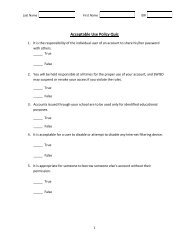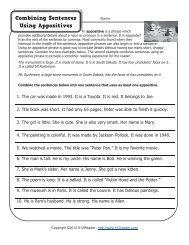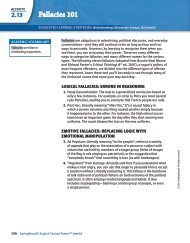Bloom's Taxonomy Blooms Digitally - Southwest High School
Bloom's Taxonomy Blooms Digitally - Southwest High School
Bloom's Taxonomy Blooms Digitally - Southwest High School
- No tags were found...
You also want an ePaper? Increase the reach of your titles
YUMPU automatically turns print PDFs into web optimized ePapers that Google loves.
<strong>Bloom's</strong> <strong>Taxonomy</strong> <strong>Blooms</strong> <strong>Digitally</strong>Andrew Churches (achurches@kristin.school.nz)Aug 22 2008 10:15PMURL:http://www.techlearning.com/article/8670from Educators' eZine<strong>Bloom's</strong> <strong>Taxonomy</strong>In the 1950's Benjamin Bloom developed his taxonomy of cognitive objectives,<strong>Bloom's</strong> <strong>Taxonomy</strong>. This categorized and ordered thinking skills and objectives.His taxonomy follows the thinking process. You cannot understand a concept if you donot first remember it; similarly, you can not apply knowledge and concepts if you do notunderstand them. It is a continuum from Lower Order Thinking Skills (LOTS) to <strong>High</strong>erOrder Thinking Skills (HOTS).<strong>Bloom's</strong> Revised <strong>Taxonomy</strong>In the 1990's, a former student of Bloom, Lorin Anderson, revised <strong>Bloom's</strong> <strong>Taxonomy</strong>and published the <strong>Bloom's</strong> Revised <strong>Taxonomy</strong> in 2001.Key is the use of verbs ratherthan nouns for each of the categories and a rearrangement of the sequence within thetaxonomy. They are arranged in increasing order, from low to high.<strong>Bloom's</strong> Revised <strong>Taxonomy</strong> Sub CategoriesEach of the categories or taxonomic elements has a number of key verbsassociated with itLower Order Thinking Skills (LOTS)• Remembering - Recognizing, listing, describing, identifying, retrieving,naming, locating, finding• Understanding - Interpreting, Summarizing, inferring, paraphrasing,classifying, comparing, explaining, exemplifying• Applying - Implementing, carrying out, using, executing• Analyzing - Comparing, organizing, deconstructing, Attributing, outlining,finding, structuring, integrating• Evaluating - Checking, hypothesizing, critiquing, Experimenting, judging,testing, Detecting, Monitoring• Creating - designing, constructing, planning, producing, inventing, devising, making<strong>High</strong>er Order Thinking Skills (HOTS)The elements cover many of the activities and objectives but they do not address the new objectives presented by the emergenceand integration of Information and Communication Technologies into the classroom and the lives of our students.
<strong>Bloom's</strong> Digital <strong>Taxonomy</strong> MapKey: Elements colored in black arerecognized and existing verbs, Elementscolored in blue are new digital verbs.RememberingThis element of the taxonomy does infer the retrieval of material. This is a key element given the growth in knowledge andinformation. The digital additions and their explanations are as follows:• Bullet pointing – This is analogous to listing but in a digital format.• <strong>High</strong>lighting – This is a key element of most productivity suites; encouraging students to pick out and highlight key wordsand phrases is a technique for recall.• Bookmarking or favorite-ing – this is where the students mark for later use web sites, resources and files. Students canthen organize these.• Social networking – this is where people develop networks of friends and associates. It forges and creates links betweendifferent people. Like social bookmarks, a social network can form a key element of collaborating and networking.• Social bookmarking – this is an online version of local bookmarking or favorites, It is more advanced because you candraw on others' bookmarks and tags. While higher order thinking skills like collaborating and sharing, can and do make useof these skills, this is its simplest form - a simple list of sites saved to an online format rather than locally to the machine.• Searching or "Googling" - Search engines are now key elements of students' research. At its simplest the student is justentering a key word or phrase into the basic entry pane of the search engine. This skill does not refine the search beyondthe key word or term.Key Terms - Remembering:Recognizing, listing, describing, identifying, retrieving, naming, locating, finding, Bullet pointing, highlighting, bookmarking, social networking, Socialbookmarking, favorite-ing/ local bookmarking, Searching, Googling.
Understanding• Advanced and Boolean Searching – This is a progression from the previous category. Students require a greater depthof understanding to be able to create, modify and refine searches to suit their search needs.• Blog Journaling – This is the simplest of the uses for a blog, where a student simply "talks" "writes" or "types" a daily- ortask-specific journal. This shows a basic understanding of the activity reported upon. The blog can be used to develophigher level thinking when used for discussion and collaboration.• Twittering – The Twitter site's fundamental question is "what are you doing?" This can be a one or two word answer, butwhen developed, this is a tool that lends itself to developing understanding and potentially starting collaboration.• Categorizing – digital classification - organizing and classifying files, web sites and materials using folders etc.• Commenting and annotating – a variety of tools exist that allow the user to comment and annotate on web pages, .pdffiles and other documents. The user is developing understanding by simply commenting on the pages. This is analogouswith writing notes on hand outs, but is potentially more powerful as you can link and index these.• Subscribing – Subscription takes bookmarking in its various forms and simplistic reading one level further. The act ofsubscription by itself does not show or develop understanding but often the process of reading and revisiting thesubscribed-to feeds leads to greater understanding.Key Terms - Understanding:Interpreting, Summarizing, inferring, paraphrasing, classifying, comparing, explaining, exemplifying, Advanced searching, Boolean searching, blogjournaling, twittering, categorising and tagging, commenting, annotating, subscribing.Applying• Runnin/ operating – This is the action of initiating a program or operating and manipulating hardware and applications toobtain a basic goal or objective.• Playing – The increasing emergence of games as a mode of education leads to the inclusion of this term in the list.Students who successfully play or operate a game are showing understanding of process and task and application of skills.• Uploading and Sharing - uploading materials to websites and the sharing of materials.This is a simple form ofcollaboration, a higher order thinking skill.• Hacking – hacking in its simpler forms is applying a simple set of rules to achieve a goal or objective.• Editing – With most media, editing is a process or a procedure that the editor employs.Key Terms - Applying:Implementing, carrying out, using, executing, running, loading, playing, operating, hacking, uploading, sharing, editing.Analyzing• Mashing – mash ups are the integration of several data sources into a single resource. Mashing data currently is acomplex process but as more options and sites evolve this will become an increasingly accessible means of analysis.• Linking – this is establishing and building links within and outside of documents and web pages.• Reverse-engineering – this is analogous with deconstruction; related to cracking without associated negative implications• Cracking – cracking requires the cracker to understand and operate the application or system being cracked, analyze itsstrengths and weaknesses and then exploit these.• Validating – With the wealth of information available to students combined with the lack of authentication of data, studentsof today and tomorrow must be able to validate the veracity of their information sources. To do this they must be able toanalyze the data sources and make judgments based on these.• Tagging – This is organizing, structuring and attributing online data, meta-tagging web pages etc. Students need to beable understand and analyze the content of the pages to be able to tag it.
Key Terms - Analyzing:Comparing, organizing, deconstructing, Attributing, outlining, finding, structuring, integrating, Mashing, linking, reverse-engineering, cracking, mindmapping,validating, tagging.Evaluating• Blog/vlog commenting and reflecting – Constructive criticism and reflective practice are often facilitated by the use ofblogs and video blogs. Students commenting and replying to postings have to evaluate the material in context and reply.• Posting – posting comments to blogs, discussion boards, threaded discussions. These are increasingly common elementsof students' daily practice. Good postings like good comments, are not simple one-line answers but rather are structuredand constructed to evaluate the topic or concept.• Moderating – This is high level evaluation; the moderator must be able to evaluate a posting or comment from a variety ofperspectives, assessing its worth, value and appropriateness.• Collaborating and networking – Collaboration is an increasing feature of education. In a world increasingly focused oncommunication, collaboration leading to collective intelligence is a key aspect. Effective collaboration involves evaluatingthe strengths and abilities of the participants and evaluating the contribution they make. Networking is a feature ofcollaboration, contacting and communicating with relevant person via a network of associates.• Testing (Alpha and Beta) – Testing of applications, processes and procedures is a key element in the development of anytool. To be an effective tester you must have the ability to analyze the purpose of the tool or process, what its correctfunction should be and what its current function is.Key Terms – Evaluating:Checking, hypothesizing, critiquing, experimenting, judging, testing, detecting, monitoring, (Blog/vlog) commenting, reviewing, posting, moderating,collaborating, networking, reflecting, (Alpha & beta) testing.Creating• Programming – Whether it is creating their own applications, programming macros or developing games or multimediaapplications within structured environments, students are routinely creating programs to suit their needs and goals.• Filming, animating, videocasting, podcasting, mixing and remixing – relate to the increasing availability of multimediaand multimedia editing tools. Students frequently capture, create, mix and remix content to produce unique products.• Directing and producing – to directing or producing a product, performance or production is a highly creative process. Itrequires the student to have vision, understand the components and meld these into a coherent product.• Publishing – whether via the web or from home computers, publishing in text, media or digital formats is increasing. Againthis requires a huge overview of not only the content being published, but the process and product. Related to this conceptare also Video blogging – the production of video blogs, blogging and also wiki-ing - creating, adding to and modifycontent in wikis. Creating or building Mash ups would also fit here.Key Terms – Creating:Designing, constructing, planning, producing, inventing, devising, making, programming, filming, animating, Blogging, Video blogging, mixing,remixing, wiki-ing, publishing, videocasting, podcasting, directing/producing, creating or building mash ups.BibliographyChurches, A. 2007, Educational Origami, <strong>Bloom's</strong> and ICT ToolsAnderson, L.W., and D. Krathwohl (Eds.) (2001). A <strong>Taxonomy</strong> for Learning, Teaching and Assessing: a Revision of <strong>Bloom's</strong> <strong>Taxonomy</strong> ofEducational Objectives. Longman, New York.Acknowledgements: For assistance, discussion and often punctuation: Miguel Guhlin, Sheryl Nussbaum-Beach, Alan Knightbridge, Sue Cattell,Raewyn Casey, Marg McLeod, Doug DeKock


